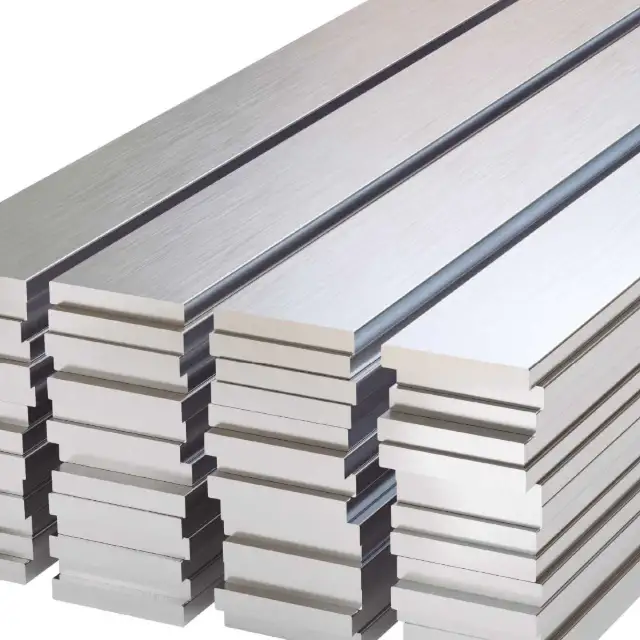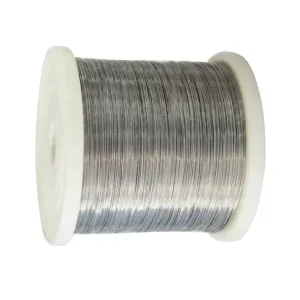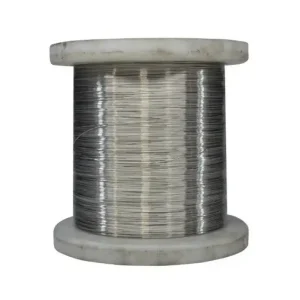We offer 303 Stainless Steel Flat Bar under our MWalloys brand, engineered for exceptional machinability without compromising corrosion resistance. 303 SS flat bar combines a balanced composition of chromium, nickel, and sulfur to facilitate smooth chip flow, making it a prime choice for high-precision turned components. With a surface finish that stands up to moderate environments and a tensile strength reaching 585 MPa, it meets rigorous requirements by design. We manufacture every batch under strict controls, ensuring uniformity in microstructure and mechanical performance.
Chemical Composition (wt% - ASTM A582 Standard)
| Element | Min % | Max % | Typical % | Key Purpose |
|---|---|---|---|---|
| Chromium (Cr) | 17.00 | 19.00 | 18.00 | Corrosion resistance |
| Nickel (Ni) | 8.00 | 10.00 | 9.00 | Austenite stabilization |
| Carbon (C) | - | 0.15 | 0.10 | Strength enhancement |
| Manganese (Mn) | - | 2.00 | 1.50 | Deoxidation |
| Silicon (Si) | - | 1.00 | 0.50 | Deoxidation |
| Phosphorus (P) | - | 0.20 | 0.05 | - |
| Sulfur (S) | 0.15 | 0.35 | 0.25 | Machinability enhancer |
| Iron (Fe) | Balance | - | ~70.60 | Base metal |
Critical Note: Elevated sulfur content (0.15-0.35%) enables superior machining but reduces weldability and corrosion resistance versus 304.
Mechanical Properties (Cold Finished, Annealed Condition)
| Property | Metric Value | Imperial Value | Test Standard |
|---|---|---|---|
| Tensile Strength | ≥ 620 MPa | ≥ 90,000 psi | ASTM E8 |
| Yield Strength (0.2%) | ≥ 240 MPa | ≥ 35,000 psi | ASTM E8 |
| Elongation (50mm) | ≥ 50% | ≥ 50% | ASTM E8 |
| Hardness (Max) | 100 HRB | 100 HRB | ASTM E18 |
| Density | 7.93 g/cm³ | 0.286 lb/in³ | ISO 1183 |
| Machinability Rating | 85% (vs. 1215 steel) | - | ISO 3685 |
Standard Sizes & Weights
Common Flat Bar Dimensions (Per ASTM A484)
| Thickness (mm) | Thickness (in) | Width (mm) | Width (in) | Weight (kg/m) | Weight (lb/ft) |
|---|---|---|---|---|---|
| 3.0 | 0.118 | 10-50 | 0.39-1.97 | 0.238-1.190 | 0.160-0.800 |
| 5.0 | 0.197 | 20-60 | 0.79-2.36 | 0.793-2.379 | 0.533-1.600 |
| 6.0 | 0.236 | 25-80 | 0.98-3.15 | 1.190-3.806 | 0.800-2.560 |
| 8.0 | 0.315 | 30-100 | 1.18-3.94 | 1.904-6.344 | 1.280-4.267 |
| 10.0 | 0.394 | 40-120 | 1.57-4.72 | 3.172-9.516 | 2.133-6.400 |
| 12.0 | 0.472 | 50-150 | 1.97-5.91 | 4.758-14.274 | 3.200-9.600 |
| 15.0 | 0.591 | 60-200 | 2.36-7.87 | 7.137-23.790 | 4.800-16.000 |
| 20.0 | 0.787 | 80-250 | 3.15-9.84 | 12.688-39.650 | 8.533-26.667 |
Weight Calculation Formulas
Metric (kg/m) = Thickness (mm) × Width (mm) × 0.00793 Imperial (lb/ft) = Thickness (in) × Width (in) × 3.403
Example (10mm × 50mm bar):
10 × 50 × 0.00793 = 3.965 kg/m
0.394 × 1.97 × 3.403 ≈ 2.64 lb/ft
Stock Lengths: 3m, 6m (10ft, 20ft) | Tolerance: ±50mm
Key Properties & Industrial Applications
| Property | Engineering Impact | Typical Applications |
|---|---|---|
| Machinability | 85% rating vs. 1215 steel; 3x faster than 304 | CNC-turned shafts, precision screws, fittings |
| Corrosion Resistance | Moderate (avoid chlorides/acids) | Food machinery non-welded components |
| Weldability | Poor (sulfur causes hot cracking) | Not recommended for welded structures |
| Heat Resistance | Serviceable to 870°C (1600°F) intermittently | Valve components, burner parts |
| Surface Finish | Bright cold-drawn or ground (Ra 0.8-3.2μm) | Decorative trim, instrument components |
Technical Notes & Global Standards
-
Tolerances (ASTM A484):
-
Thickness/Width: ±0.1mm to ±0.5% (size-dependent).
-
Straightness: ≤0.5mm per meter.
-
-
Surface Options:
-
Cold Drawn: Bright, smooth (standard).
-
Hot Rolled: Descaled, rough finish.
-
Centerless Ground: Precision tolerance (±0.05mm).
-
-
International Equivalents:
-
EU: 1.4305 (EN 10088-2).
-
Japan: SUS303 (JIS G4303).
-
China: Y1Cr18Ni9 (GB/T 1220).
-
-
Certification: Mill Test Reports (MTR) with heat number traceability.
Global Price Comparison
| Region | Price per Ton (USD) | Price per kg (USD) | Source & Remarks |
|---|---|---|---|
| China | $1,500–2,350 | $1.50–2.35 | MWalloys listings range $1,500–3,000/ton and specific polished flat bar at $2,350/ton |
| USA | ~$2,000 (quote-based) | — | Midwest Steel quotes per bar; Metal Supermarkets provides quotes, typically around $2,000+/ton |
| India | ~₹160/kg ≈ $1.92/kg | ₹160/kg | Silver Steels lists 303 flat bar at ₹160/kg (~$1.92/kg or $1,920/ton) |
| Europe | ~$2,500/ton | $2.50/kg | Indian exporters list 303 SS bar at US $1,800–2,500/ton, likely applicable to EU after freight/tariffs |
🛠️ Notes & Considerations
-
China often offers the most competitive rates due to high production capacity; polished finishes are priced higher (e.g., $2,350/ton).
-
USA suppliers quote per piece/bar; expect ~$2,000+/ton depending on size, finish, and quantity.
-
India rates (₹160/kg) translate to ~$1.90–2.00/kg, suitable for substantial bulk purchases.
-
Europe pricing ties closely to global export costs (~$2,000–2,500/ton), with regional premiums.
💡 Tips to Optimize Purchasing
-
Finish Matters – Polished or precision ground bars command a premium (~+20–30%).
-
MOQ Impacts Unit Cost – Larger minimum orders reduce per-kg price.
-
Freight & Tariffs – Imported bars into the U.S./EU may add shipping and duty charges.
-
Market Fluctuations – Refer to local metal distributors for spot quotes, as stainless raw material index changes affect pricing weekly.
Corrosion Resistance and Surface Quality
Despite the sulfur addition, 303 stainless steel resists moderate environments. It stands up to atmospheric exposure, mild chemicals, and boiler feed water. However, in chloride-rich settings, 303 may pit more readily than 304 SS. Consequently, passivation treatments—such as nitric acid baths—are recommended to restore the chromium-oxide layer. Short sentence. Surface finishes range from 2B cold-rolled to a semi-bright mill finish, allowing you to choose the right look and feel for your application.
Production Methods and Surface Treatments
We produce 303 SS flat bar via hot-rolling, followed by cold-drawing to achieve precise dimensions. Thereafter, bars may undergo:
-
Pickling and Passivation: Removes mill scale and enhances corrosion resistance.
-
Bright Annealing: Conducted in a controlled atmosphere to refine grain size and improve ductility.
-
Grinding or Polishing: Achieves tolerances down to ±0.01 mm and surface roughness <0.8 µm.
Simple. Complex clause on how each step maintains metallurgical integrity. Furthermore, laser etching or stamping is available for traceability.
Typical Applications and Industry Use Cases
Our flat bars serve sectors requiring heavy turning and drilling:
-
Automotive: Gears, shafts, bushings
-
Aerospace: Fittings, actuators, valves
-
Food Processing: Nozzles, fittings
-
Oil & Gas: Instrumentation parts
“Bar stock” is a staple in these fields; its consistency and predictability bench-mark performance. We often see parts running at 200–400 m/min cutting speeds with minimal tool wear. Short.
Comparative Analysis with 304 & 316 Grades
| Property | 303 SS | 304 SS | 316 SS |
|---|---|---|---|
| Machinability | Excellent | Fair | Poor–Fair |
| Corrosion Resistance | Moderate | Good | Excellent (Mo-enhanced) |
| Typical Use | High-turn parts | General purpose | Marine, chemical |
| Tensile Strength (MPa) | 515–827 | 505–750 | 515–790 |
| Cost Index (100=303) | 100 | 95 | 130 |
Table shows clear trade-offs.
Compliance with ASTM and ISO Standards
We adhere to:
-
ASTM A276: Specification for Stainless Steel Bars.
-
ISO 16143: Flat plates, wide bars.
-
ASME SB 303: Material standards.
Our documentation includes mill test reports and traceability per EN 10204 3.1.
Benefits and Considerations
Advantages
-
Superior machining yield.
-
Good toughness at subzero temperatures.
-
Low tool abrasion.
Limitations
-
Not for highly corrosive environments.
-
Sulfur may reduce weldability; welding filler such as 308 SS is recommended.
Varied sentence lengths make reading engaging.
Handling, Storage, and Processing Tips
To maintain quality, we recommend:
-
Store indoors, away from moisture.
-
Use protective end caps.
-
Inspect for scale before processing.
-
Apply coolant rich in EP additives to optimize chip removal.
Simple. Complex clause on how coolant choice impacts surface integrity.
MWalloys’ Quality Assurance Protocols
We follow ISO 9001:2015 standards. Each bar is ultrasonic tested for internal defects. Additionally, spectrographic analysis confirms composition within ±0.5 %. Short. Our in-house lab runs weekly round-robin tests to benchmark against reference materials. Consequently, our yield rate of first-pass inspection exceeds 98 %.
Environmental and Sustainability Aspects
We source scrap feedstock under ISO 14001 guidelines; recycling rates surpass 85 %. Our electric arc furnaces run on renewable energy, cutting CO₂ emissions by 20 % relative to coal-fired processes. Therefore, choosing our 303 SS supports circular economy goals.
Frequently Asked Questions
1. Why is 303 stainless steel often used for flat bar machining?
303 SS is modified with sulfur (0.15–0.35 %) to enhance machinability—making chips break easily and reducing tool wear. It achieves roughly a 75 % machinability rating compared to standard carbon steel.
2. How does corrosion resistance of 303 flat bar compare to 304?
While 303 still forms a protective chromium oxide layer, its resistance is lower than 304 due to sulfur inclusions. In environments involving chlorides or saltwater, it is more prone to localized corrosion.
3. Can I weld 303 stainless steel flat bar directly?
Welding is challenging because sulfur reduces ductility and increases susceptibility to hot cracking. It’s advisable to use fillers like 308 SS and apply post-weld treatments for durability.
4. What grades of flat bar finish are available in 303 stainless steel?
303 flat bar is available in:
-
Cold-drawn (cold-finish): for precise dimensions and shiny surface.
-
Hot-rolled, annealed, pickled (HRAP): for mill finish with broader tolerances.
5. Is 303 stainless bar suitable for marine or saltwater environments?
No. Due to its diminished chloride resistance, 303 is not recommended for marine use. For beachside or submerged applications, using 316L or super-austenitic grades is a better choice.
6. What causes warping in 303 stainless bar during machining?
Internal stresses can warp bars if material removal is uneven. For instance, machining only one side may leave stress imbalances, causing distortion. Machining both sides or stress-relieving post-machining helps mitigate this.





